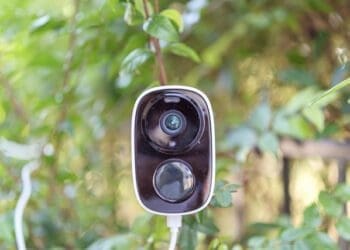In today’s fast-paced world, home automation technology offers unparalleled advantages in security, convenience, and energy efficiency.
Smart homes integrate intelligent systems that automate tasks related to safety, comfort, and well-being, allowing you to control and monitor your home remotely.
With home automation, you can enhance security through automated lighting, motion sensors, and security cameras that deter burglars and provide peace of mind.
These smart home devices and systems not only provide security benefits but also offer remarkable convenience by automating routine tasks and processes.
Compatible gadgets can be triggered by different events, such as turning on lights when you unlock the front door or adjusting the thermostat based on your preferences.
This seamless integration of technology into your living space elevates your home experience, allowing you to enjoy the advantages of home automation to their fullest potential.
What is Home Automation?

Definition and overview of home automation
Home automation refers to the automatic control of electronic devices and systems within a home environment, allowing for remote monitoring and management of various appliances and features.
It involves the integration of intelligent systems that automate tasks related to security, comfort, convenience, and energy efficiency, enabling homeowners to control and monitor their homes remotely.
Explanation of how it connects various devices and systems
Home automation works by creating a network of devices that are connected to the internet through different communication protocols, such as Wi-Fi, Bluetooth, ZigBee, and others.
These devices are equipped with sensors and electronic interfaces, enabling them to communicate and interact with one another seamlessly.
Through this interconnected system, homeowners can manage and control various devices remotely, either via a voice assistant like Alexa or Google Assistant or through a dedicated app on their smartphone or tablet.
Centralized control through a hub or smartphone
In a home automation setup, devices can be controlled and managed through a central hub or a smartphone app.
The hub acts as the brain of the system, processing data and communicating wirelessly with all the connected devices.
It combines the functionalities of various apps into a single, unified interface, allowing homeowners to control and automate their smart home devices from a single point.
Alternatively, many home automation systems also offer direct connectivity to a router, eliminating the need for a separate hub and enabling control through a dedicated mobile application.
Home automation systems operate on three levels: monitoring, control, and automation.
Monitoring allows users to check the status of their devices remotely through an app. Control enables users to manage these devices remotely, such as panning a security camera or adjusting the thermostat.
Automation takes it a step further by allowing devices to trigger one another based on predefined rules or conditions, such as having a smart siren activate when a security camera detects motion.
Benefits of Home Automation

Convenience and remote control
Home automation systems offer unparalleled convenience by enabling homeowners to control various aspects of their homes remotely.
With a smartphone or tablet, they can easily adjust thermostats, turn lights on or off, lock or unlock doors, and even monitor security cameras, all from anywhere in the world.
This level of remote control eliminates the need for manual adjustments, saving time and effort in daily routines.
Additionally, home automation systems allow for seamless integration with voice assistants like Amazon Alexa, Google Assistant, and Apple HomeKit, enabling hands-free control through simple voice commands.
This feature adds an extra layer of convenience, making everyday tasks even more effortless.
Energy efficiency and cost savings
One of the most significant advantages of home automation is its ability to optimize energy consumption, leading to substantial cost savings.
Smart thermostats, for instance, can intelligently adjust temperatures based on occupancy and preferences, ensuring optimal heating and cooling while minimizing energy waste.
This not only reduces utility bills but also contributes to environmental sustainability.
By eliminating unnecessary energy usage and extending the lifespan of bulbs through precise control, smart lighting systems contribute to lower electricity bills and reduced maintenance costs over time.
Furthermore, smart plugs empower users to remotely monitor and control power consumption for various appliances and electronics.
By scheduling devices to operate during off-peak hours or automatically turning them off when not in use, smart plugs help minimize standby power consumption and eliminate wasteful energy usage, resulting in lower electric bills.
Improved security and safety
Home automation systems offer enhanced security and safety features that provide peace of mind to homeowners.
Intelligent surveillance cameras, smart locks, and motion sensors enable remote monitoring and real-time alerts, ensuring homeowners can keep an eye on their property even when away.
Integration with existing security systems allows for seamless control, such as arming or disarming the system remotely and receiving alerts in case of security breaches.
Additionally, automated lighting and simulated occupancy routines can deter potential intruders by creating the illusion that someone is at home.
In the event of emergencies like fires or carbon monoxide leaks, home automation systems can automatically alert authorities and initiate evacuation procedures, minimizing property damage and ensuring the safety of occupants.
Customization and personalization
Home automation systems offer a high level of customization, allowing homeowners to tailor their home’s settings to suit their preferences and lifestyles. Personalized schedules for lighting, heating, and cooling can be set up to optimize energy efficiency and create the ideal environment.
Moreover, homeowners have the freedom to define personalized rules and automation scenarios based on their daily routines.
The integration of home automation systems with other smart home devices, such as smart lighting, thermostats, and voice assistants, enables comprehensive automation where multiple devices can respond to specific events and triggers.
This level of customization and personalization ensures that the home automation system adapts to the unique needs and preferences of each household.
Smart Home Devices and Features

Smart thermostats and lighting controls
Smart thermostats are Wi-Fi enabled devices that automatically adjust heating and cooling temperatures in your home for optimal performance and energy savings.
Many smart thermostats learn your temperature preferences and establish schedules that automatically adjust to energy-saving temperatures when you are asleep or away.
They also feature geofencing capabilities that can detect when you’re on your way home and adjust the temperature accordingly.
Smart lighting systems offer customizable settings to suit your mood and save energy.
You can set schedules, dim lighting, and even change colors – all controlled by your phone or voice commands.
Smart bulbs like the Wyze Bulb Color support app and voice control, allowing you to turn lights on/off, adjust brightness, and change colors without getting up.
Security cameras and alarm systems
Home security systems integrate smart cameras, sensors, and alarms to enhance home protection.
Many providers like ADT, Vivint, SimpliSafe, abode, Ring, and Cove offer seamless integration with voice assistants like Alexa and Google Home for arming/disarming the system and controlling smart locks or lights.
Advanced cameras can detect people, animals, or packages and send real-time alerts.
Systems like Front point allow creating automation rules, like automatically locking doors and arming the system when leaving the geofenced area.
Indoor and outdoor cameras can record 24/7 for continuous video security.
Voice assistants and smart speakers
Voice assistants like Amazon Alexa, Google Assistant, and Apple’s Siri, integrated into smart speakers, offer convenient control over various smart home devices through voice commands.
Smart speakers act as hubs, allowing you to control lights, thermostats, security systems, and even access live camera feeds using your voice.
They can also recognize multiple voices for personalized responses.
Smart appliances and home entertainment systems
Smart home technology extends beyond climate control, lighting, and security, encompassing appliances and entertainment systems as well.
Smart refrigerators can track inventory, create shopping lists, and even suggest recipes based on available ingredients.
Smart ovens and cooktops offer precise temperature control, pre-programmed recipes, and remote monitoring capabilities.
In the entertainment realm, smart TVs and streaming devices enable voice control, personalized recommendations, and seamless integration with other smart home devices.
Home theater systems can be automated to create immersive experiences, adjusting lighting, sound, and even curtains based on the content being played.
By integrating these smart devices and systems, homeowners can create a truly automated and interconnected living environment, enhancing convenience, security, and energy efficiency throughout their homes.
Conclusion
The modern home automation revolution has ushered in a new era of convenience, energy efficiency, and security.
By seamlessly integrating intelligent systems and devices, homeowners can enjoy unparalleled control and personalization, tailoring their living spaces to suit their unique preferences and routines.
From smart thermostats that optimize energy consumption to advanced security cameras that provide round-the-clock vigilance, home automation has redefined the way we interact with our living environments.
As technology continues to evolve, the possibilities for home automation are boundless.
With each innovation, homeowners can expect enhanced functionality, streamlined integration, and even greater energy savings.
Embrace the future of home automation and unlock a world of comfort, convenience, and peace of mind within the sanctuary of your smart home.
FAQs
What are the key advantages of automating your home?
Automating your home offers several significant benefits, including the ability to save money, enhance security and safety, reduce energy usage, and increase convenience.
It also allows for more effective use of appliances, improves home comfort, provides insights about your home, and improves accessibility for individuals with disabilities or limited mobility.
How does home automation work, and what are its pros and cons?
Home automation involves integrating technology into the design of a space to automate tasks related to security, well-being, and comfort through a smart system.
This system makes it possible to control various aspects of your home or building remotely.
A key advantage of home automation systems is their ability to increase energy efficiency. However, the specifics of disadvantages were not detailed in the provided information.
What issues can home automation address?
One of the primary issues that home automation can solve is the problem of burglary and theft from porches.
Many homeowners turn to automation for its security benefits, as crime data indicates that about 88% of burglaries are residential.
Unfortunately, only 13% of these incidents are resolved due to the lack of physical evidence or witnesses. Home automation can provide a layer of security to help mitigate these risks.
What are the most common applications of home automation?
The three most common uses of home automation include controlling lighting, security systems, and HVAC (heating, ventilation, and air conditioning) regulation.
Smart lighting systems allow for the remote control of lights, whether you’re home or away, enhancing both convenience and security.
Security systems can be automated for better home protection, and HVAC regulation can improve energy efficiency and comfort.





















































